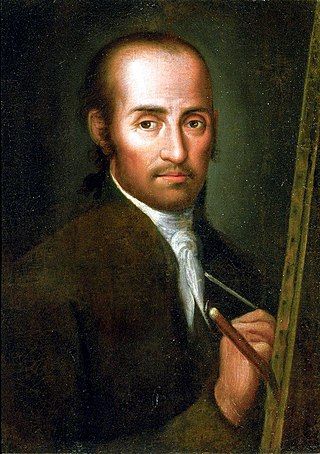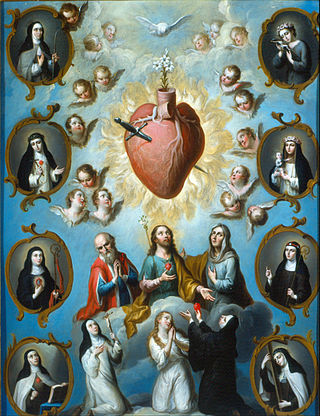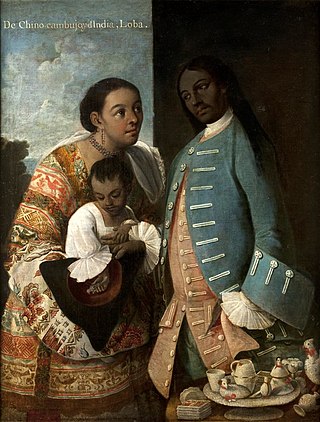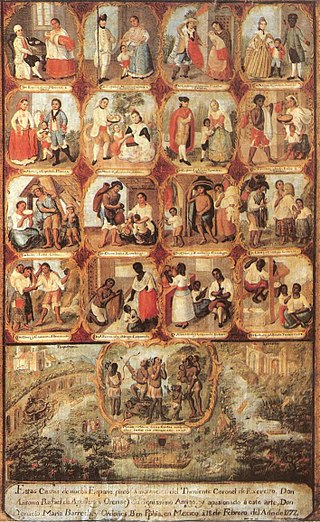
Casta is a term meaning lineage or race in Spanish and Portuguese. The term has historically been used as a racial and social identifier for mixed-race offspring in the colonial Spanish Empire in the Americas. The Spanish crown created a basic legal division between Hispanic society and Indigenous peoples, mainly living in indigenous communities. In the Hispanic sector were Spaniards, Black Africans, and mixed-race castas.

Miguel Mateo Maldonado y Cabrera (1695–1768) was a Mestizo painter born in Oaxaca but moved to Mexico City, the capital of Viceroyalty of New Spain. During his lifetime, he was recognized as the greatest painter in all of New Spain. He created religious and secular art for the Catholic Church and wealthy patrons. His casta paintings, depicting interracial marriage among Amerindians, Spaniards and Africans, are considered among the genre's finest. Cabrera's paintings range from tiny works on copper to enormous canvases and wall paintings. He also designed altarpieces and funerary monuments.
Latin American art is the combined artistic expression of South America, Central America, the Caribbean, and Mexico, as well as Latin Americans living in other regions.
Gente de razón is a Spanish term used in colonial Spanish America and modern Hispanic America to refer to people who were culturally Hispanicized. It was a social distinction that existed alongside the racial categories of the sistema de castas. Indigenous peoples, who maintained their culture and lived in their legally recognized communities, and mixed-race people, especially the poor in urban centers, were generally considered not to be gente de razón.

The Museo de América is a Spanish national museum of arts, archaeology and ethnography in Madrid. Its collections cover the whole of the Americas and range from the Paleolithic period to the present day.

José de Ibarra (1688–1756) was a New Spanish painter. He was born in Guadalajara, Mexico in 1688, and died November 21, 1756, in Mexico City, in the Viceroyalty of New Spain. Ibarra was a disciple of the distinguished painter Juan Correa (1646-1716), whose parents were of Afro-Moorish Afro-Mexican descent. José de Ibarra is, along with Juan Rodríguez Juárez (1675-1728), one of the most prominent figures in painting from the first half of the 18th century in New Spain, modern day's Mexico. A follower of the artistic renewal promoted by the brothers Juan and Nicolás Rodríguez Juárez, in whose workshop he collaborated, Ibarra cultivated in his work the language of pictorial modernism with strong Italian and French influences. This would be the direct antecedent of the work of Miguel Cabrera (1715-1768), whose fame would eclipse that of which Ibarra himself enjoyed among his contemporaries as a brush artist.

Juan Correa (1646–1716) was a distinguished Mexican painter of the late seventeenth and early eighteenth centuries. His years of greatest activity were from 1671 to 1716. He was the Afro-Mexican son of a mulatto physician from Cádiz, Spain, and a freed black woman, Pascuala de Santoyo. Correa "became one of the most prominent artists in New Spain during his lifetime, along with Cristóbal de Villalpando."Manuel Toussaint considers Correa and Villalpando the main exponents of the Baroque style of painting in Mexico. James Oles writes that "Correa and Villalpando created a distinctive—if at times formulaic—style that hearkened back to the strong Mannerist traditions of the mid-sixteenth century."

Various types of visual arts developed in the geographical area now known as Mexico. The development of these arts roughly follows the history of Mexico, divided into the prehispanic Mesoamerican era, the colonial period, with the period after Mexican War of Independence, the development Mexican national identity through art in the nineteenth century, and the florescence of modern Mexican art after the Mexican Revolution (1910-1920).

Juan Rodríguez Juárez was an artist in the Viceroyalty of New Spain. He was a member of a Spanish family long noted for their accomplishments in the world of painting. His brother was Nicolás Rodríguez Juárez (1667–1734), who was like himself, an established painter in New Spain. He was the son of Antonio Rodríguez (1636–91), a notable Spanish painter. His maternal grandfather José Juárez (1617–1661) and maternal great great grandfather Luis Juárez (1585–1639) were also notable painters in Spanish history and prominent in the Baroque era.
While the Casta system was flourishing in New Spain (1519-1821), a painters' guild emerged in order to classify the different ‘races’. The painters' guild in New Spain paralleled the structure, purpose, and mobility of the Casta system they were representing.
An unpublished manuscript entitled Ordenanzas del Baratillo de México was signed and dated in 1754 by Pedro Anselmo Chreslos Jache, likely a pseudonym for an educated Spaniard. It is a satirical piece of eighteenth-century colonial literature written in New Spain, which sought to offer an alternative view of life in colonial Spanish America.

Francisco Clapera (1746–1810) was a Spanish painter who after training in Spain lived and worked in Colonial Mexico. Here he was one of the few foreign painters to create casta paintings, a distinctive Mexican genre that depicts in sets of consecutive images scenes of racial mixing among the Indians, Spaniards and Africans who lived in the Spanish colony.

Juan Patricio Morlete Ruiz was an 18th-century Mexican painter, a mestizo according to the system of racial classification. He is most well known for his casta paintings.

In the former Portuguese and Spanish colonies in the Americas, pardos are triracial descendants of Southern Europeans, Indigenous Americans and West Africans.

José de Páez (1720–1790) was a Mexican painter of religious images, a history painting of the destruction of Mission Santa Cruz de San Sabá in Texas, and a set of casta paintings in the 18th century. He was of Baltazar de Páez, José is identified student of Nicolás Enríquez. He married Rosalía Caballero in 1753.
The ideas of the Spanish Enlightenment, which emphasized reason, science, practicality, clarity rather than obscurantism, and secularism, were transmitted from France to the New World in the eighteenth century, following the establishment of the Bourbon monarchy in Spain. In Spanish America, the ideas of the Enlightenment affected educated elites in major urban centers, especially Mexico City, Lima, and Guatemala, where there were universities founded in the sixteenth and seventeenth centuries. In these centers of learning, American-born Spanish intellectuals were already participants in intellectual and scientific discourse, with Spanish American universities increasingly anti-scholastic and opposed to “untested authority” even before the Spanish Bourbons came to power. The best studied is the University of San Carlos Guatemala, founded in 1676.

Coyote is a colonial Spanish American racial term for a mixed-race person casta that usually refers to a person born of parents, one of whom a Mestizo and the other indigenous (indio).

Lobo is a racial category for a mixed-race person used in Mexican paintings illustrating the caste (casta) system in 17th- and 18th-century Spanish America.

Ignacio María Barreda was an eighteenth-century Mexican painter, self-identified as university graduate with a Bachiller in philosophy. Mexican art historian Manuel Toussaint noted him for his portraits, including two of elite women, reproduced in his publication, and others of elite religious men. Toussaint believed he might be the official painter for the Seminario de San Camila, His 1777 single-canvas casta painting is an exemplar of this eighteenth-century genre of secular art. It is similar in some ways to the 1750 single-canvas painting by Luis de Mena, which also includes outdoor scenes near Mexico City, particularly the Paseo de Ixtacalco.

José Joaquín Magón was a late eighteenth-century Mexican painter from Puebla de los Angeles.
















